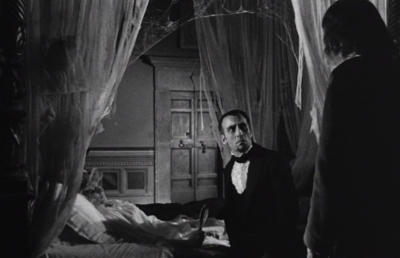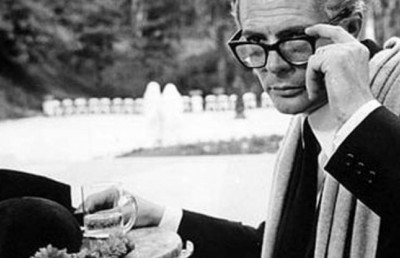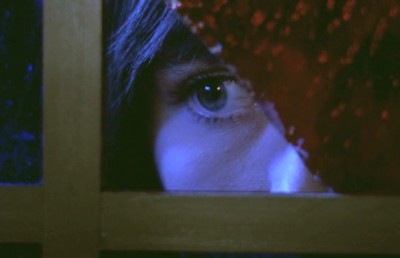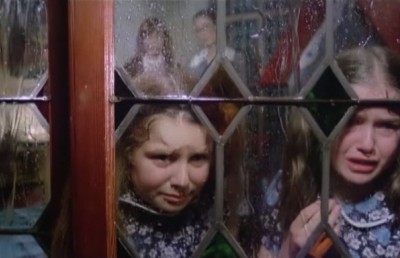Francesco Barilli’s Dual Gems: The Perfume of the Lady in Black (1974) and Pensione Paura (1977)
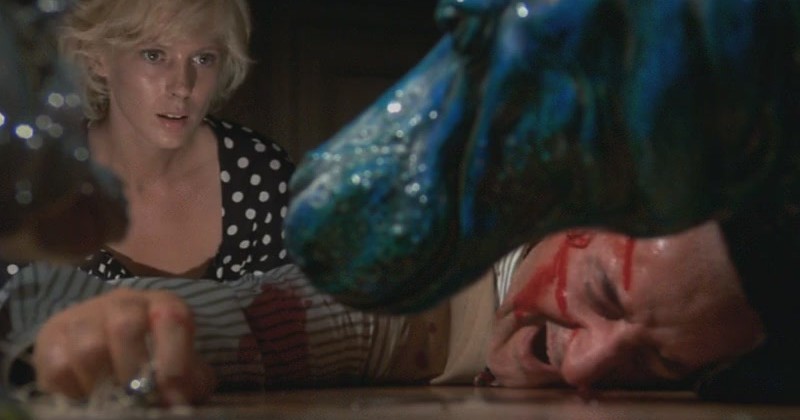
Director Francesco Barilli has only two horror films to his credit, The Perfume of the Lady in Black (1974, and Barilli’s first film) and Pensione Paura (Hotel of Fear, 1977), the latter which fits more comfortably in the tradition of the giallo, but they are corkers which should be better known by fans of Italian and eurohorror. The relatively late availability of the first to home DVD in a English-friendly version, and the lack of such for the second, is a partial explanation for their relative obscurity. People who have worked with Barilli and experienced his vast cultural knowledge of cinema and art, were quick to label him a “genius” often frustrated by the more prosaic aspects of the Italian film industry (as Luc Meranda stated on the Pensione Paura special feature, Barilli did not tolerate ignorance). Barilli filters many films and directors in what is perhaps the most unique Italian horror films from the 1970s, The Perfume of the Lady in Black. A few that stand out are Mario Bava’s Lisa and the Devil (the use of Alice in Wonderland, the use of the abandoned villa) and Roman Polanski’s Rosemary’s Baby and Repulsion (with Mimsy Farmer as Sylvia channeling both Mia Farrow and Catherine Deneuve –short blond hair, light eyes, sense of vulnerability, paranoia, pale complexion).
The Perfume of the Lady in Black gives a clear indication of a unique stylistic quality common to Barilli, stemming from his fine art background (both within his family and his own immediate skills as a well-known painter). On the The Perfume of the Lady in Black DVD special feature Barilli admits that the idea for the film came from one of his paintings of the titular lady in black, seated with her back against the viewer, a painting seen in the film and which cuts the subject as a sad, lonely figure, a theme which is also established across many of the key characters (namely Sylvia and the retired widowed professor, Signora Rossetti). What distinguishes this horror film is a sophisticated visual quality seen across the art design, color, graphic use of the frame and use of props, sets, and costumes, melded to a potentially exploitative plot (or in the least, conventional). Its greatness lie in the details: sets, props, tiny acting gestures, recurring color patterns, mirror shots, etc. As a plot it veers between two strains: the woman losing touch with reality plot; or the conspiratorial “Gaslight” plot (with a hint of Rosemary’s Baby) where the woman’s immediate reality is conspiring to drive her mad (Italian gialli in this vein include All the Colors of the Dark, 1972 and The Short Night of Glass Dolls, 1971). The classic template for this “conspiracy horror” film was molded by Roman Polanski in his three masterpieces, Repulsion, 1965, Rosemary’s Baby, 1968 and, the later, The Tenant, 1976.
The film opens with an impressive crane shot from a fountain square up to a balcony of a Roman apartment complex, where we see the retired professor Signora Rossetti (Mario Scaccia) watering his plants. Farmer plays a young professional, a chemist, Sylvia Hacherman, who lives alone in this same compex and has trouble pleasing her geologist boyfriend Roberto’s demanding nature. Suggesting a hint of feminism, the boyfriend Roberto (Maurizio Bonuglia) gets angry when she chooses work over a night with him. Rossetti, who has an odd fascination with hippos, is one of Slyvia’s many oddball neighbors (this penchant for adding unique details to secondary characters is a Barilli trait). Sylvia meets with some of Roberto’s foreign friends at a party, including an African professor Andy (Jho Jenkin) who tries to convince Sylvia that Africa still practices witch craft and modern forms of human sacrifices. The setting for the talk is itself suggestive: filmed from high above, the people sit on modern lawn chairs amid a jungle like backyard.
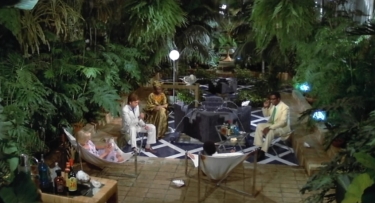
The reference to Third World backwardness and superstitious beliefs may be a sly critique of Italian stereotypes of Africa (and Third World nations), especially as depicted in many Italian mondo films. The professor reveals his story to be a joke, but the seed is already planted for the film’s still shocking ending.
Along with the retired professor, Sylvia’s nieghbors include a young woman who may harbor a lesbian interest in Sylvia, Francesca; the crooked shaped porter Luigi, and a woman overly concerned over her a dog. In the DVD special features interview Barilli reveals that the film was a composite of two scripts he had been working on, one dealing with a woman who goes insane, the other with cannibalism. When he couldn’t get a producer to back the latter he decided to combine them and we get a film which is ostensibly a psychological thriller which hits a wall and becomes something entirely else for the final few minutes. Barilli also describes the film in a way which suggests a possible political/metaphorical/philosophical reading: he said the idea for film was not to make a gut crunching cannibal/zombie film but to depict “a world that chooses you, stalks you, makes you crazy and then eats you.” Of course there is not enough in the film to suggest such a symptomatic reading, but it lets the viewer know that Barilli does not see working in a popular filoni as a limitation.
An element that links The Perfume of the Lady in Black to his second horror film, Pensione Paura, is the wholly unappealing and un-erotic manner in which sex is depicted. Like in Pensione Paura, the sex act in Perfume is filmed in the most unglamorous manner. Men are slimy, sweaty, and wholly unattractive (morally if not physically). In most instances the sex scenes are rapes, or very close to them. Barilli has back to back sex scenes early in the film (about 20 minutes in), the first between Sylvia and Roberto. In this scene the sex act is overwhelmed by the loud off-screen sounds of night time forest crickets. Roberto’s body movements are jagged and aggressive rather than rhythmic, and Sylvia’s facial expression, caught in close-up, seems aloof and distant. In the next scene Sylvia is walking along the street and stops to look into a storefront window, where she imagines the traumatic sex act (the primal scene) which has haunted her since childhood in the window’s reflection. Staring up at her is a man, Nicola (Orazio Orlando), in blue-collar t-shirt on top of her mother, looking up at her with an ugly, animal-like expression. Whether a hallucination or real, Nicola attempts to rape Sylvia later in the film in the abandoned villa where she spent time as a child. Sex is never an act of love in Barilli’s films, but an act of trauma, aggression or a prelude to death (a fact which subverts the usual protocol of sexual titillation common to the terza visione popular film).
Sex as Nightmare in the Films of Barilli

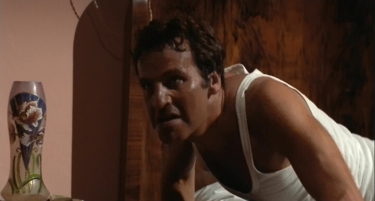
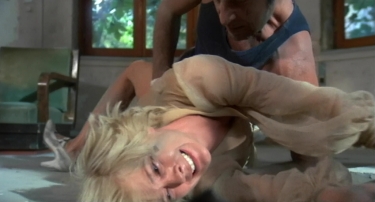
The Perfume of the Lady in Black
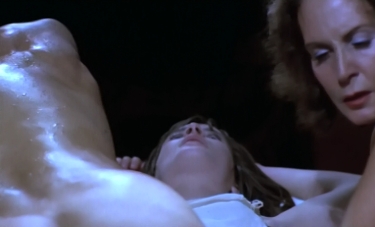
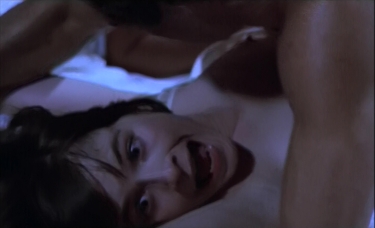
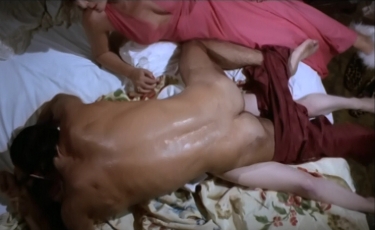
Pensione Paura
Perfume is heavily indebted to Freud, as are many horror films and many gialli, with traumatic primal scenes triggering a neurosis fueled domino-like descent into madness. Although the film leaves open the possibility of a conspiracy of evil pulling her into madness, the plot more directly offers the childhood trauma where she witnessed her mother (Renata Zamengo) being raped, and victim of a mysterious death, perhaps pushed to her death (an act that is repeated by Sylvia in her suicide), as a source of her growing madness (she begins to wear her mother’s black with white polka dots dress when her fantasy side takes over her psyche). Her upbringing is also marked by having lost her sailor father at a young age to a drowning accident. As a manifestation of her trauma, Barilli includes several subjective daydreams (which function almost as flashbacks) of these events and, most brazenly, has Sylvia actually interact with herself at the age she was when she experienced the trauma, about 7-8 years old, interestingly foreshadowing a similar gesture in a later Mia Farrow vehicle, Full Circle, where the Farrow character interacts with a ghost girl who she thinks is her dead daughter.
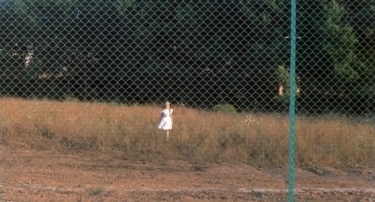
Sylvia’s child fantasy phantom first appears to her in broad daylight during a friendly tennis match with the African man. A cut on her hand, which the African man attends to by sucking the cut, triggers a memory, perhaps of a similar childhood injury. Her younger self (played by Lara Wendel) appears in a surreal mirage —with striking white dress against dull background— walking toward her along the fields beyond the tennis courts, filmed through the court fence. Reflective surfaces seem to be Sylvia’s undoing, as the haunted figures she imagines seeing (or are planted by her conspirators) often come to her in windows, mirrors, and similar reflected surfaces. The scene of her mother’s rape (or violent sex) is first seen in a storefront reflection, and then a second time in her own apartment, where she opens the bedroom door and sees the primal scene enacted in her own psychological space. The act is seen in the flesh but also reflected in a background mirror.
“Mirroring” Phantoms

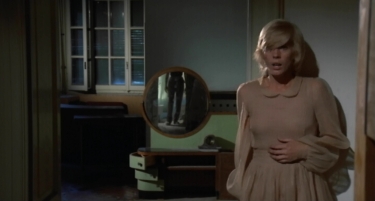
A true image of madness is wonderfully contrived by Barilli when her mother’s lover/rapist Nicola leaves the bed to stalk Sylvia (the man’s lower body is in darkened silhouette as he moves toward the camera, but a quick view of his large member is visible). The camera does not immediately follow the man’s progression toward Sylvia, but instead remains on the image of her crazed mother, with flowing jet black hair, cowering on the bed below a stark painting of a second woman, her back facing us, also sitting on a bed.
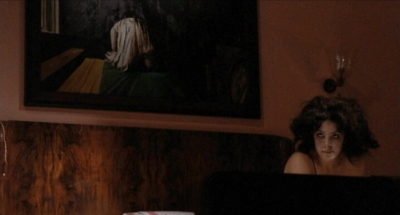
When the man reaches Sylvia the scene cuts to a young Sylvia thrusting a knife into his face. Barilli’s deft use of mise en scene is evident in the transition from the past (fantasy) to the present (reality) through the change in set design of the room: from warm brownish hues and old style furniture in the fantasy, to cool blues and modern furniture in the present, with the same painting over the bed acting as the bridge between the two states.
Primal Scene Space Revisited (note background mirror reflection of evil rapist in top image)
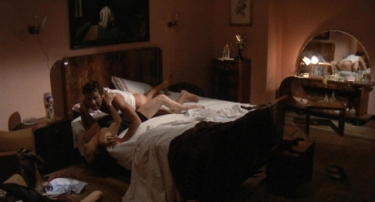
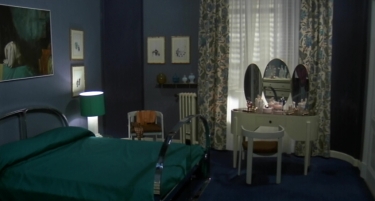
Barilli cleverly uses a wide angle lens and high angles to exaggerate the space of Sylvia’s apartment, making her feel overwhelmed and emphasizing her state of loneliness. The overhead angle becomes a motif, culminating in the final bird’s eye view of her nude corpse on a sacrificial altar. Another important contribution to the film’s bizarre atmospheric blend of subtlety and graphicness, realism and hallucination is the score by composer Nicola Piovani, which contains stark switches from a languid, melancholic lullaby to grating experimental tones.
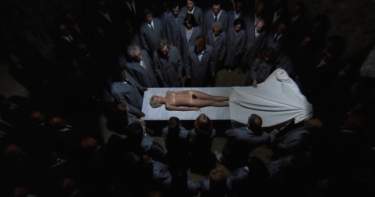
Along with camera angle and music, Barilli constantly uses props, sets, and color to depict the character’s inner state of mind or mood. When Francesca brings Sylvia a bouquet of yellow flowers, the camera ends the scene on a close-up of the flowers and then cuts to Sylvia in bed, her outstretched arm conveniently holding open an edition of Lewis Carroll’s Alice in Wonderland. The camera pans right to Sylvia in an all-yellow bed, the color yellow recalling the flowers of course, but also perhaps suggesting the acceptance of her fantasy. The motif of flowers is omnipresent in Barilli’s mise en scene. The yellow flowers brought by Francesca are placed in a flower-designed pot that is identical to one owned by Sylvia’s mother (if not the exact one). The ultra-modern Francesca’s apartment is an eye-sore of faux nature and kitschy bric-bracs. The séance is run by a blind clairvoyant named “Orchedia” (Nike Arrighi) and the room hosting the séance is adorned with flowered wallpaper and curtains.
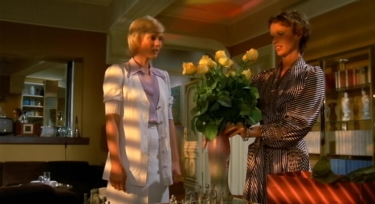
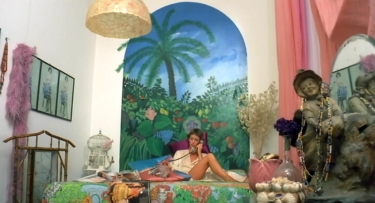
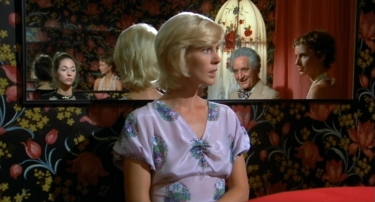
Francesca seen in all three images
The potential duplicities of Sylvia’s ‘friends’ and neighbors is suggested in a shot where the camera frames an uncertain Sylvia in front of a mirror reflecting herself and three other people around the table (still above). The three people stare at her with contrasting expressions: the blind clairvoyant looks blankly away from Sylvia; Francesca looks on with a menacing gaze; while the Mr. Rossetti smiles lavisciously. Barilli stages the fantasy scenes with just the right mix of realism and expressionism. The recreation of Sylvia’s (real or imagined) matricide on her bedroom veranda evokes the bifurcated (realist/expressionist) style within the same shot: the foreground interior bedroom space is quiet, serene, earth toned (realist); the background image of the overlooking veranda space is a surreal rainbow colored sky with matching celebratory streamers (expressionist). This set is repeated near the end in one of the most bizarre suicides ever filmed, where Sylvia’s younger self “pushes” her older self off the roof.
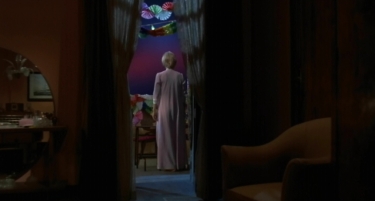
Barilli leave us in the lurch with his sledgehammer ending, which in its graphic scenes of cannibalism invokes Romero’s Night of the Living Dead, along with the ending of Rosemary’s Baby, while still truthful to the film’s themes of loneliness and alienation (suggested in the bleak colors and setting). Although the ending is emotionally jarring, the film also leaves dangling plot points that can only be answered by placing them as aspects of Sylvia’s disturbed consciousness. For example, encouraged by her child alter ego, who tells her “everyone around her is evil,” we see her violently kill Nicola, Mr. Rossetti, and Roberto only to see them appear alive and well in the final scene of human sacrifice. We can only conclude that she has imagined these murders, as perhaps she imagined killing her own mother. For the sledgehammer ending, Barilli abandons subtle mannerisms for all-out gore. We have seen characters arrive at this dank location earlier in the film, but without explanation or insight. Now we see all the minor characters that Sylvia interacted with, dressed in uniform grey, quietly arrive at this subterranean cavern where (as related in the Curti interview, was filmed at the Caracalla thermals) Sylvia’s nude corpse is offered on a slab as a human sacrifice. Roberto makes the initial incision into her stomach, and then the others hungrily pull out organs and feast on them like wild animals, recalling the zombie attacks in Romero’s Night of the Living Dead. No further explanation is offered. Instead, cinematographer Mario Masini literally leaves the spectator in the proverbial dark, by slowly tracking his camera back from a long shot of the rambling cannibals just outside the perimeter of the room, along a dark tunnel, stopping when the image is almost pitch black. The gesture of pulling out of the room, but not entirely out of the horror, makes for a most unsettling feeling.
Barilli reveals his sophisticated cinematic pedigree with allusions to directors Polanski (noted above), Alfred Hitchcock (who Barilli has expressed great admiration for in interviews) and perhaps Italy’s greatest modernist filmmaker, Michalengelo Antonioni. The taxidermy store where Sylvia goes to get a dog stuffed (and where she meets an older Nicola, her mother’s rapist) is a bizarre cross between the opening pet shop scene in Hitchcock’s The Birds and the parlor room scene in Hitchcock’s Psycho. The deep focus shot where Sylvia visits her abandoned childhood home, framed through a screen door looks uncannily similar to a shot from Antonioni’s early masterpiece of alienation, Il Grido, 1957.
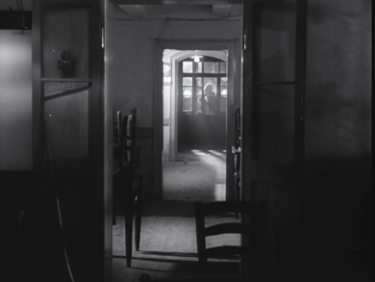
Il Grido
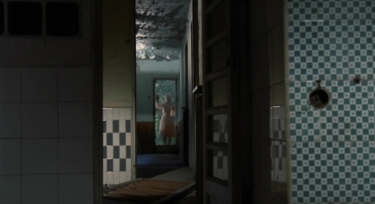
The Perfume of the Lady in Black
Barilli’s second horror film Pensione Paura out does The Perfume of the Lady in Black with its great cast: Luc Merenda as lecherous playboy/wartime black marketer Rodolfo; Leonora Fani as the sexually repressed Rosa, who is forced to run the family hotel on her own after the accidental death (murder?) of her mother, Marta (Lidia Biondi), twenty-five minutes into the film’s ninety-two minute running time; Francisco Rabal as Marta’s lover Alfredo, who spends the whole film locked in a room hiding from his past (an informant who fears that he will be chased down and plans to hide until the end of the war); and Jole Fierro as Rodolfo’s middle-aged bourgeois lover. Like The Perfume of the Lady in Black, the score (piano-driven by Adolfo Waitzman) is great, as is the cinematography by Gualtiero Manozzi.
The film is set, appropriately enough, in Pupi Avati’s Emilia-Romagna territory, in a small rural setting near the end of World War 2, and concerns the sexualized and horrific comings and goings among the dozen or so hotel denizens. Like Avati’s The House with the Laughing Windows (1976), this is a film full of thematic resonance, with the dreadful sense of claustrophobia first among the thematic links. In a great homage to Windows, Barilli includes one scene which is scathing of the church. Rosa visits the town priest to ask for some food on credit. The priest refuses, implying that he has another ‘arrangement’ with her mother; Rosa asks why it is that he gave her mother credit. When she leaves the camera, which is fixed behind a white sheet, pans slightly as the priest pulls away the sheet to reveal a table and a hardy meal exposed underneath it, to which he sits down to eat. When a young boy, who we learn is in love with Rosa, criticizes the priest, he scolds him and tells him to fetch some wine!
Although sex is rampant in the hotel, most of the guests give the impression of being lonely. Along with Marta’s lover, Alfredo, who is a prisoner in his own room, there is the the waiter who sleeps in a small hovel off the kitchen. The other pensioners tend to their rooms playing sexual parlor games (late in the film Rosa turns on hallway lights and sees a man pleasuring a woman orally up against a wall).
As suggested in the previous description, the corridors in the hotel are dark and labyrinth-like, sometimes lit in saturated primary colors, a la Argento, post- Suspiria. In terms of influence, it is interesting to note that Pensione Paura was released in the same year as Suspiria, which means the similarity in lighting style may have been a question of “two minds thinking alike”. The internal claustrophobia is matched by a sense of decadence which is in the art design (like the water-logged gazebo we see Rosa in at the beginning of the film) but also in the morality of the people: all the hotel occupants seem to have something to hide or are living in the past, or are spying on their neighbors. One man only wants to talk about how his son and wife died. Marta’s lover Alfredo hides like a rat in his room (we later discover that we was a ‘rat’, an informant). His unsavory past is literalized in a shot where Alfredo looks into a dirty mirror and sees his ‘darkened’ reflection (past).
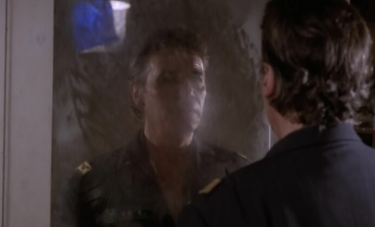
Rudolfo has the best (that is, vilest) moment when he spies on Rosa (who he lusts over every chance) through her bedroom keyhole, and then tries to convince her to let him into her room. As a last resort, he places his penis (implied in his body movements) in front of the peephole and tries to ‘encourage’ Rosa to see what she’s missing. His crudity is disrupted by the arrival of his middle-aged lover.
The film opens with Rosa in an idylic setting, out on a rowboat in the bright sunlight. The opening sets us up to expect something completely different, a coming of age story, or an sunny period piece, but this will be one of the last time’s we get to see sunshine. We hear Rosa’s voice-over as she hopes for the return of her father from the war, and swears that she will never leave until he returns (making the hotel her own personal ‘prison’); even when she learns that he is dead, she continues to dream his return, a father obsession which links Rosa to ??The Perfume??’s Sylvia. The film ends with a similar voice-over, which in denial of the facts, tells us she has lost her grip on reality.
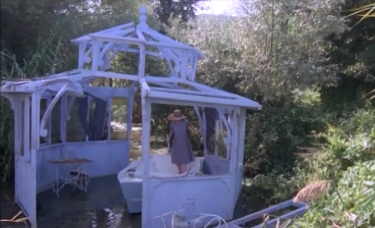
Genteel Decadence
Leonora Fani’s performance as Rosa is great, and she is one of the more interesting female characters in Italian horror/giallo cinema. It is unfortunate that her career sputtered after a successful foray into Italian comedy and horror/gialli in the 1970s, including the notorious Giallo a Venezia, 1979. Quite contrary to Mimsy Farmer, the younger, dark-haired Fani carries herself with more confidence through her own “wonderland.” She begins as a young naïve virgin, who shuns the lecherous Rudolfo. After the death of her mother she begins to take responsibility, first for her mother’s lover Alfredo (by feeding him, but not servicing his sexual needs), then for the hotel clients. She learns of the truth behind Rudolfo’s scheming relationship with the older lady: a set of criminals show up and she eavesdrops on their plan. First they kill a man and steal two false passports from him. Rudolfo asks for the passports, but the two men say that he will only get them when they receive the jewels, which are the property of Fierro, which explains the reason why he maintains a relationship with her.
However, when Rudolfo discovers that Rosa is smart to his plan, this places her in an even more vulnerable position. Fierro feigns a motherly attitude toward Rosa and gets her into their bedroom, setting her up for Rudolfo’s rape scene, which ranks as one of the sleaziest scenes in any Italian filoni (and that is saying quite a bit!). An overhead shot of the rape (64’00”) captures Meranda’s muscular, sweaty body clamoring over hers, engulfing her like a huge spider (see photo in the above “sex-as-nightmare” montage). Rudolfo’s grotesquely made-up lover looks on in scopophilic joy, as if sublimating herself into Rosa’s younger body. The rape is clearly a turn on for the lady, who caresses Rudolfo’s backside after he rolls over exhausted. Meanwhile other men listen to Rosa’s cries from outside the room or from within their own room, complicit in their silence. The rape scene is wholly repulsive and as far as erotic as can be imagined (perhaps surpassed in depravity only by the gang rape in The Pajama Girl Case / La ragazza dal pigiama giallo, 1977). This relates to The Perfume of the Lady in Black which, as noted, also has unwholesome, unerotic sex scenes.
In the next scene we see Rosa nude over a basin, in front of a mirror, washing out her vagina (each time Rudolfo touches her she washes herself in an effort to cleanse away his evil). Later that night we see a giallo-like cloaked killer enter Rudolfo’s bedroom and stab him and her lover to death (or apparent death in Rudolfo’s case). In giallo style, the killer’s identity is kept secret, and there are the requisite red herrings. Marta’s lover is seen just before with a knife in his hands and opening his wardrobe. Or maybe it is Rosa’s father who has returned? Or maybe Adolfo the waiter? Rosa attempts to cover up the crime, whose ever it is, by dragging the corpses into the basement thermal baths. When Rudolfo kicks back to life momentarily and reaches out for Rosa, she instinctively grabs a pole and whacks him a few times and runs off, leaving them both uncovered in the thermal bathtub.
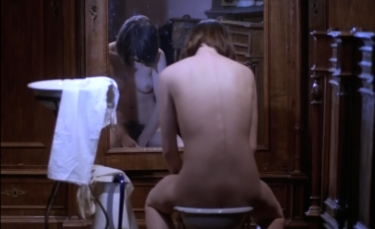
The two thugs surprise Rosa while she is intimate with her young admirer, thinking she has the jewels. She manages to elude them and runs away, straight into an ongoing orgy between guests, who grab her and dunk her into a vat of dirty water. A trench coat dressed man (shot in half darkness) appears out of nowhere and begins to shoot everyone in the room, mob style. When Rosa sees the man she yells “father” and runs into his arms. Instead we learn that this savior is not her father, but a friend of her father, who tells Rosa that her father is dead, and that he has come to kill Alfredo. Rosa pleads with him to not kill Alfredo. In an effort to change his mind she begins to kiss him passionately. The man then tells Rosa that Alfredo’s betrayal led to the death of fifteen “of us” (partisan/resistance fighters no doubt, including Rosa’s father). After this revelation Rosa urges him on –“kill him!”– which he does. The man tries to convince Rosa to leave with him, but she refuses. In a gesture which comes close to fixing this as a giallo, or stands as a reflexive commentary on the giallo, Rosa admits to her father’s friend that she dressed up as her father and killed Rudolfo and his lover. We cut to a revelation/flashback scene where, in a nod to Bava’s Sei donne per l’assassino, a trench coated figure we assume to be male is revealed to be a woman (Rosa drops her knife, and removes her hat, like the mask/hat removal in the Bava film).
As vile as it is, the rape scene triggers something in Rosa. We later learn exactly what. At first it is perhaps her sexuality, as she becomes more assertive with the young boy who loves her, and later with her father’s friend. But she also becomes a killer, hence the rape first triggers vengeance (she kills the two people responsible for her rape while they are asleep, Rudolfo and his lover), but then she goes further, killing the young man who came back to avenge her father’s memory. Now she has gone beyond vengeance/honor to just plain insane/psychotic.
Rosa’s transformation becomes complete in the penultimate scene, before she kills the young resistance fighter. While seated in front of a mirror, she applies makeup and then the dark sunglasses we saw Rudolfo wearing, and places a cigarette in her mouth (she did not smoke during the course of the film, but Rudolfo did). This transformation seems to be partly one of going from a female to a male, a substitute father figure perhaps, but also from a subservient virgin to a mature woman. Or perhaps it is also an homage to the end of Seven Beauties, and the final shot of the prostitute/wife and Pasquale in front of the mirror.
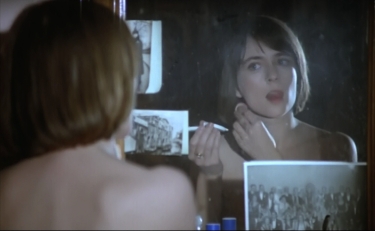
In the final scene, Rosa, dressed in a similar trench coat, goes out to meet with the young man who is leaving the hotel. She embraces him, telling him she loves him. When he wraps both arms around her we hear a shotgun. Gun in hand, Rosa walks back to the hotel, as the voice-over begins, which seems to be a letter she wrote to her father, pledging allegiance to her promise to never leave until he returns (“I will keep all the windows closed until the day you arrive…..”). She enters the door, and draws the curtain shut. The camera zooms in to a closer view of the door; with her emotional voice-over continuing, she shuts the door behind her and the film ends on this bleak note (echoing the bleak ending of Renoir’s The Rules of the Game, 1939): What will she do, live on alone in the hotel? Will she continue to take in other guests? The bleak ‘dark’ ending echoes the similar fate at the end of Perfume.
Although a grim horror tale, Pensione Paura can also be read as a metaphor for the war and Fascism. For example, Marta sleeping with the traitor (Alfredo) is a metaphor for Italians who sided with the Fascists/Hitler (just as the grey cloaked cannibals suggest Fascist conformity in The Perfume of the Lady in Black). The sexually decadent guests can be seen as Pasolini-like jabs at Fascists. Rudolfo and the other black sedan driving criminals are the black marketers, etc. The priest who eats well while others starve could be a direct mirror of any form of luxury during times of duress. The descent of the Rosa character from naïve, good person to insane psychopath can in itself be seen as a metaphor for Italy’s transformation to Fascism. In both cases, Pensione Paura and The Perfume of the Lady in Black, Barilli succeeds in meeting and surpassing the demands of the horror/giallo genre, while adding a layer of sophistication through his intelligent, painterly use of light and set design, and thematic subtext (both philosophical and political). Barilli’s diptych are unheralded gems of Italian popular cinema which should be better known, at the level of such peers as Argento, Sergio Martino, Fulci, and Pupi Avati.



